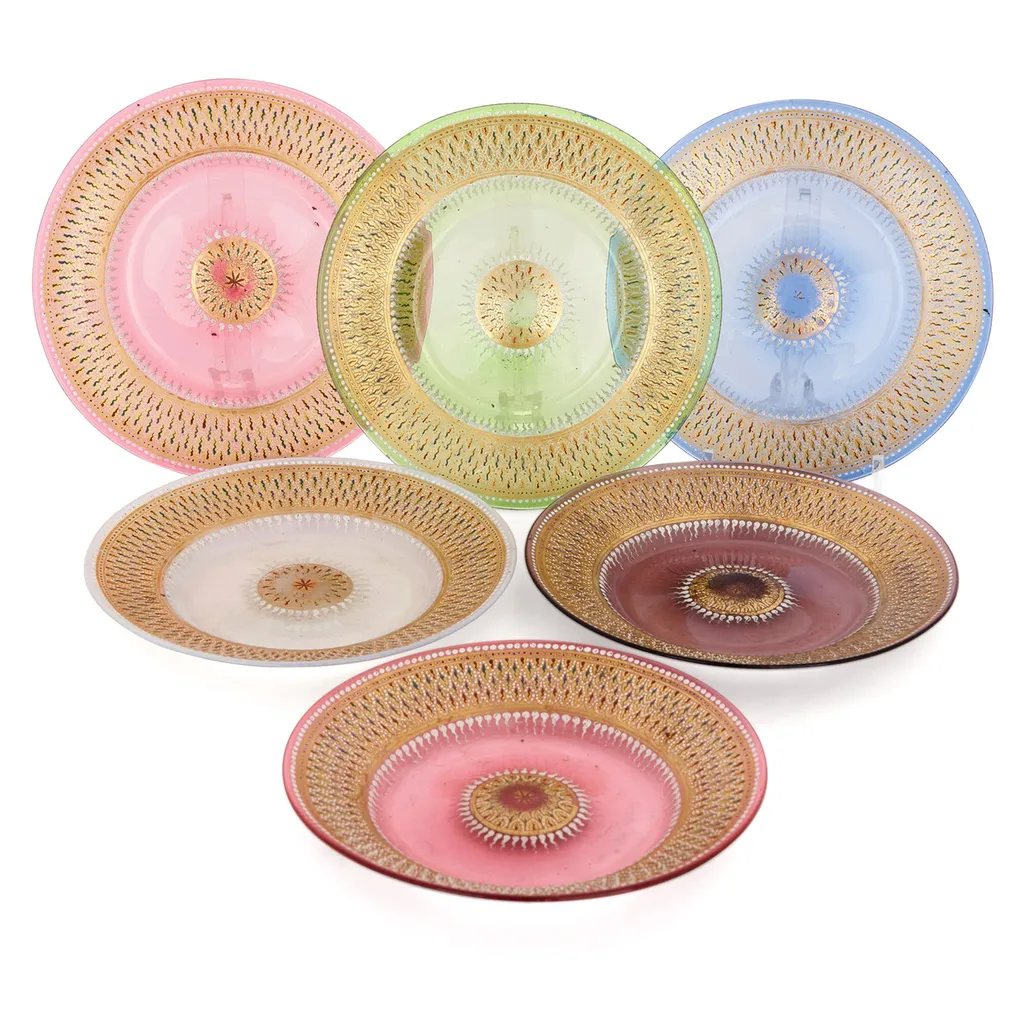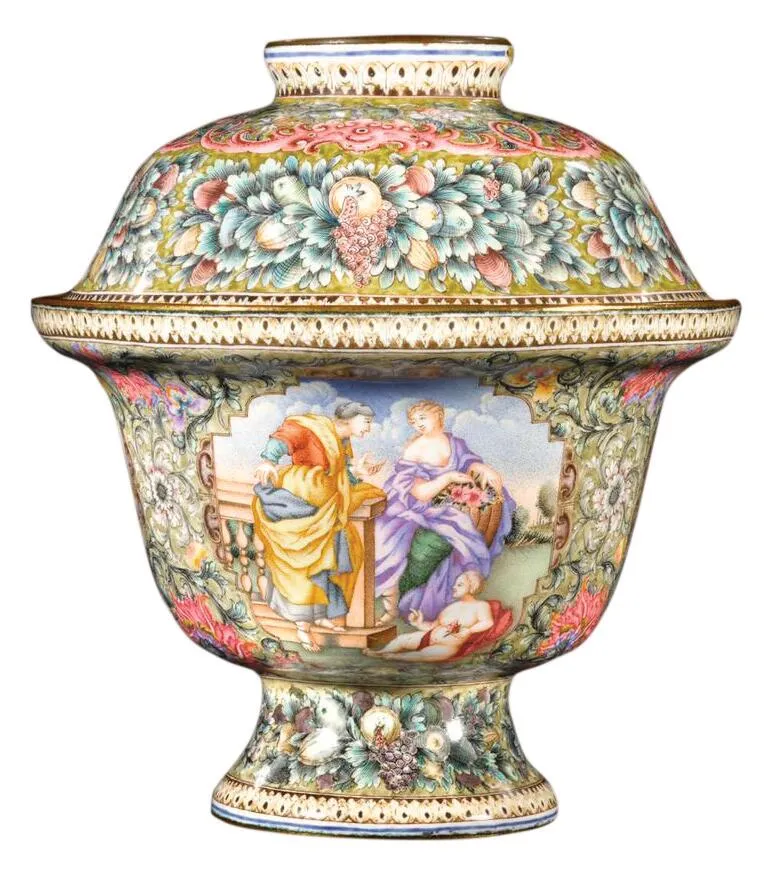What is enamel?
Combining the durability of metal with the delicacy of glass, enamel – or vitreous enamel, to give it its full name – is colourful, translucent and often exquisite. Down the centuries a huge range of objects and ornaments have featured enamel, from Fabergé’s Easter eggs via vases, clocks and jewellery to humble kitchenware, such as coffee pots and serving dishes.
What is the history of enamel?
A highly skilled technique, in which powdered glass and pigment are exposed to high temperatures in order to create a liquid, the origins of enamelling are unclear, but it is thought to have been invented by the ancient Egyptians, who applied enamels to stone objects, pottery and sometimes jewellery.
The Greeks, Celts and Chinese carried on the tradition, using enamel on metal objects, while the Romans applied it to glass. In Europe, enamel reached a peak of popularity in the Middle Ages, when the French city of Limoges became famous first for its champlevé enamelwork from the 12th century onwards and then, in the 15th century, for its painted enamel.
However, the most prevalent enamelling technique through history has probably been cloisonné, which came from either Byzantium or the Islamic world. Becoming well established in China during the 13th and 14th centuries, cloisonné remained popular in China until the 19th century, and is still produced there today. The most elaborate and highly valued Chinese pieces date from the early Ming dynasty (15th century), although 19th and 20th-century pieces are now much easier to find.
China’s near-neighbour Japan started producing its own cloisonné in large quantities, and of very high technical quality, from the 1850s onwards. Exquisite vases, bowls, boxes and other decorative items by artists such as Namikawa Yasuyuki and Namikawa Sōsuke are now extremely collectable.
Among the other most prominent forms, painted enamel can be very valuable, with even small pots showing the finest workmanship fetching around £2m. ‘Austria specialised in plates, dishes, clocks, vases, teapots, even cabinets on wooden bases with enamel panels,’ explains Daniel Sinai, Director at London’s Mayfair Gallery. ‘Many works copied Renaissance designs, featuring rock crystal and lapis lazuli and illustrations and decorations drawing on classical mythology.’

In the late 19th century, Russia rivalled Austria for exquisite enamelware. One famous silversmith was Peter Carl Fabergé, the jeweller famous for his fabulous Easter eggs. Some 50 were created between 1885 and 1916 for TsarsAlexander IIIandNicholas IIas Easter gifts for their wives and mothers – 43 eggs survive today.
But 19th-century Russia should be known for more than Fabergé’s eggs. ‘Various Russian artels – cooperative associations of craftsmen living and working together – produced beautiful enamelwork at this time, such as tea sets, beakers and kovshi – traditional oval-shaped Russian drinking ladles,’ Daniel explains.
How much should you expect to pay for enamel?
When starting to acquire an enamel collection of your own, John Jaffa, who has run The Antique Enamel Company in London’s Earls Court for 40 years, recommends small English painted enamels – snuff boxes, perfume bottles and bonbonnières – produced in Staffordshire during the 1700s. John’s stock includes an impressive range of patch boxes (used to store beauty patches for disguising blemishes), often with mottoes.
‘South Staffordshire enamels from 1760 start at around £250, and their inscriptions (‘A token of regard’, ‘Trifles shew respect’) are delightfully whimsical,’ says John. For collectors in the middle range of the market, he suggests Russian cloisonné, which can start at around £750 for a 19th-century kovsh or spoon. For larger budgets, exquisite Austrian, Swiss and French enamel gold boxes start at around £10,000.
What enamel is most collectable?
John Axford is Chairman and Asian Art specialist at Woolley & Wallis. ‘I would recommend Chinese 18th-century painted enamel,’ he says. ‘A lot of this was made for the export market – produced to sell into Europe and featuring ‘Western’ themes. Because of this, it’s now not so popular with Chinese buyers, who prefer things that were made for the home market. Many of these designs will be copies of Ming-era Chinese motifs. You can find some unbelievably beautiful objects at reasonable prices – £150 upwards, or even less if it has a little damage.’

He also recommends looking at slightly later work from Japan. ‘When I started at Woolley & Wallis in 1993, Japanese enamel was much more sought after than Chinese. The Japanese market was very strong in the world, whereas China was a closed country. Today, though, as soon as it says ‘Japanese’, Chinese buyers are just not interested, meaning Japanese art is left to a world of proper collectors. For the same money you will find far better pieces in Japanese art.’
You may also like:
Types of enamel to look out for
Vitreous enamel is a decorative technique in which powdered glass is layered onto a variety of background surfaces – usually metal, but also ceramics, glass, stone and others – at high temperatures. The powdered glass melts, flows and then hardens on the background surface, creating a brilliantly coloured decorative effect.
Techniques include cloisonné, in which thin strips of metal are bent and curved to follow the outline of a decorative pattern; they are then attached, usually soldered, to the surface of the object, forming miniature walls. Within these walls the powdered enamel is laid and fused.
Another popular technique is champlevé where, instead of building on the surface of the metal object, the surface is gouged away, creating channels separated by thin ridges of metal that form the outline of the design. The troughs are filled with powdered enamel and fused. The Becket Casket, made in 12th-century Limoges and housed in the V&A is one of the most famous examples.
Other techniques include basse-taille, in which the metal is carved before the enamel goes on, and plique-à-jour (‘letting in daylight’), which resembles cloisonné but achieves a stained-glass effect by the absence of a back plate, a famous example being the French c1400
Mérode Cup.
Sitting somewhat apart from these techniques is painted enamel, in which a vessel is coated with enamel, painted and fired. Again, Limoges features here, where painted enamel was applied to copper from the mid 1400s.
Where to buy antique enamel
The Antique Enamel Company
Suite 63, 235 Earls Court Road, London, SW5 9FE theantiqueenamelcompany.com
Gould Antiques
PO Box 36330, London, NW2 5YF gouldantiques.com
Mayfair Gallery
39 South Audley Street, London, W1K 2PP mayfairgallery.com
Woolley & Wallis
51-61 Castle Street, Salisbury, Wiltshire, SP1 3SU woolleyandwallis.co.uk